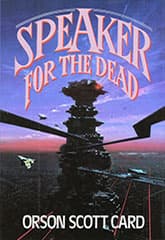Speaker for the Dead
Critique • Quotes
 First edition
First editionFirst publication
1986, United States
Literature form
Novel
Part of series
Ender's War (including Ender's Game and Speaker for the Dead) and the Ender series or Enderverse (1985–present)
Genre
Science fiction
Writing language
English
Author's country
United States
Length
Approx. 128,500 words
Like nothing before
The sequel to Ender's Game picks up three thousand years later on a distant planet where humans have run into another potentially dangerous alien species with some mysterious consequences. Andrew "Ender" Wiggin, who is still only in his thirties due to his constant space travel at near-light speeds (don't try to figure it out), is brought in. With him come all the ideas introduced briefly at the end of Ender's Game.
This novel though is nothing like the one before it. The plot is in the form of a mystery, or rather several mysteries, as Ender tries to uncover what has happened between the humans and the aliens they call "piggies".
More importantly he works to understand the psychology of both species, to sort out the morality of humanity on other worlds—all the issues that were neglected in the first novel.
If the first novel reminded me of the more militaristic works of Robert A. Heinlein, this one is closer to the progressive perspective of Ursula K. Le Guin. Like much of the latter's work, it sensitively probes the link between species and the environment and delves into the complexity of the characters' interrelations—all the while presenting an absorbing story. There are hints of this in Ender's Game but they really blossom in Speaker for the Dead.
Queen of the buggers
Card was obviously inspired by Le Guin when he wrote this. He even employs the ansible device, introduced in her novels to allow instantaneous communications, avoiding the usual light-speed restrictions throughout the universe.
Ender in this novel is also secretly engaged on another mission. He's carrying the cocoon of the dormant queen of the "buggers" he had previously massacred to find a new world for her to restart her species. It's his attempt to atone for what he had done in Ender's Game—and perhaps for us to atone for having enjoyed reading his earlier exploits.
Speaker for the Dead is an intriguing and often moving piece of work. It's depth is as impressive as Card's craftsmanship in bringing together all the levels of the story.
Apparently Speaker for the Dead was the first of the two novels Card had envisioned. The author says he wrote Ender's Game only to give the character's back story. Personally I think the back story could have been much abbreviated to let us get to the heart of the Ender saga faster, but I realize that many science fiction fans will be enticed by the action of the first novel into the more profound issues of the second. I only hope serious readers don't give up after the first.
Ender's endless war
Many more volumes of the Ender's Game series, sometimes referred to as the Enderverse, have been published since Speaker for the Dead—and are still being published at this time of writing.
But the first two novels make a complementary pair, complete in themselves in my opinion. The first book alone is not enough, as it takes off in another direction near the end that makes sense only if you read the second, while the second book pretty well concludes the issues raised. Individually they each won science fiction's biggest awards and together they were once issued as Ender's War.
Some later books in the Enderverse, such as Xenocide (1991) and Children of the Mind (1996), continue the Ender saga after Speaker for the Dead.
Others tend to fill in perceived gaps in the first two novels. For example, Ender's Shadow (1999), Shadow of the Hegemon (2001), and Shadow Puppets (2002) are mainly from the perspective of Bean, Ender's ally during his training for the bugger war. They take place first simultaneously with the action of Ender's Game and then in the period after the war.
First Meetings (2002) is mostly a collection of stories taking place after the bugger war and before the events of Speaker for the Dead, including one story showing Ender's decline from earth's hero to villain.
And the series goes on. As of this writing, eighteen Ender volumes have been published, with more on the way. Many readers seem to love them all and you're welcome to take up permanent residence in the Enderverse if you wish..
But really, the first two novels tell enough of the whole story, and the rest are overblown and unnecessary—and just not as brilliantly written.
— Eric
Critique • Quotes

